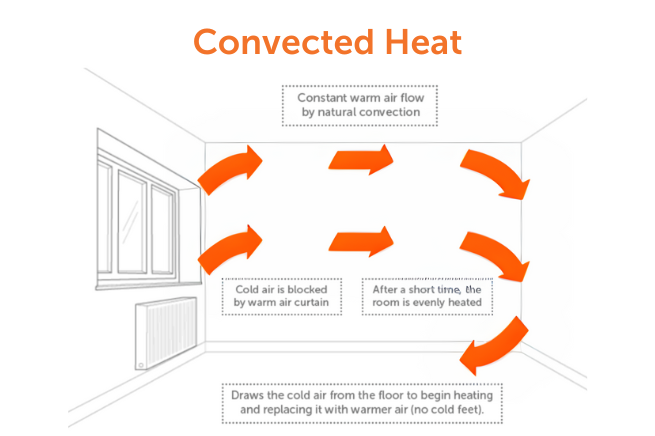
Whether you’re stepping into the world of conservatory heating for the first time or thinking about upgrading you existing set up, you might be wondering about the most energy efficient way to keep your conservatory snig and warm throughout winter. Well, you’re in the right place! Today, let’s delve into the world of heating methods. We’re going to unpack the terms ‘convected heat’ and ‘radiant heat’ and introduce you to some fantastic radiators that masterfully blend these two methods.
The Basic of Conservatory Heating
Let’s start with the basics: heating is all about making your conservatory space more comfortable, especially when the temperature drops during winter. In a world of conservatory heating, there’s a bit of a buzz around terms like ‘convection’ and ‘radiant’ heat or heaters. You might have hear them mentioned now and then, sometimes even set up as rivals. It’s important to have an understanding of what these terms really mean, as they are they key to heating your conservatory effectively.
Think about conservatories for a moment. They’re often beautiful spaces with lots of glass windows, right? While they’re fantastic at letting in that lovely sunlight, they also have a tendency to let the cold air sneak in. And here’s the kicker: it’s not just about keeping you warm and cosy, proper heating in your conservatory is key to preventing pesky issues like mould and condensation. Neglect your heating, and you might find yourself dealing with damaged furnishings, or even worse pricey structural work to attend to. So, choosing the right heating method isn’t just a matter of comfort; it’s also about caring for you and your conservatory. With that in mind, let’s delve into exploring the heating methods available to effectively heat your conservatory.
Understanding Convected Heat

What is Convected Heat?
Convected heat is essentially a gentle, invisible cycle of warmth in your conservatory. it involves heating the air in the room. The warmed air then rises, and as it cools it falls down to be heated again.
How Convection Works in Conservatories:
In a conservatory, a convection heater warms the cooler air near the floor. The heated air rises and circulates throughout the space, creating a warm and inviting conservatory.
Pros and Cons of Convection:
-
Pros: Evenly heats the entire conservatory, economical for long term use, perfect for both smaller spaces and large spaces, safe with no exposed heating elements, cost effective.
-
Cons: Can be slower to heat up than other heating methods, less effective in drafty areas.
Understanding Radiant Heat
What is Radiant Heat?
Think of radiant heating as the same way you feel warmth when standing in the sun. Unlike convected heat, radiant heating warms object and people directly.
How Radiant Heat Works in Conservatories:
Radiant heaters emit infrared rays that directly heat the surfaces they touch - for instance your furniture or you - making them great for immediate warmth.
Pros and Cons of Radiant Heat:
-
Pros: Provides quick heat distribution, direct heat, doesn’t dry out the air, suited for small spaces and short term use.
-
Cons: Heat is not distributed evenly, not suited for larger spaces, only heats people or objects and not the room.
Combining Convection and Radiant Heating
Heaters that combine both methods, like our Butterfly range, offer the best of both worlds. These electric radiators work by a heating element embedded into a soapstone core. As cold air rises through the radiator it begins warming and is released into the surrounding air at the top of the radiator - this is the convection process. The soapstone core is excellent at retaining heat, so you are also able to fell the benefits of radiant heat nearby the radiator.
This combination ensures gentle air movement for comfort and targeted radiant warmth. It’s a perfect solution for spaces like conservatories due to the thermostat controls, meaning you can heat your conservatory only when needed.
In conclusion, conservatories benefit greatly from a thoughtful choice between convection and radiant heating, depending on the specific needs of the space. For those seeking a versatile and efficient solution, heaters that integrate both methods, such as the Butterfly range, offer an excellent balance, ensuring your conservatory remains comfortably warm in all conditions. To find out just how many radiators you may need for your conservatory, why not use our handy calculator?